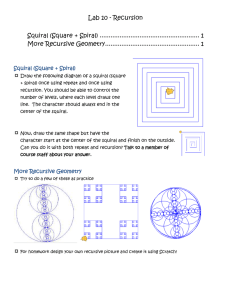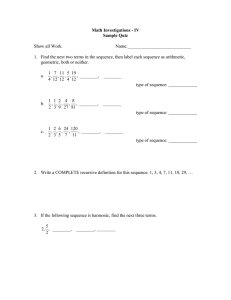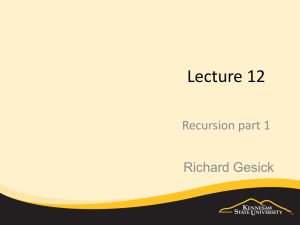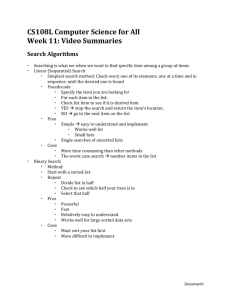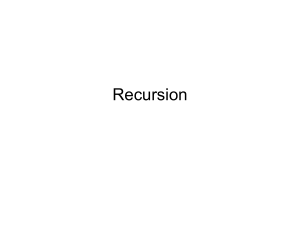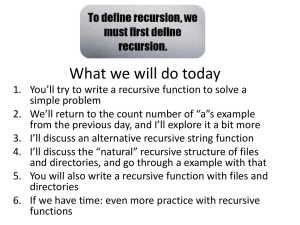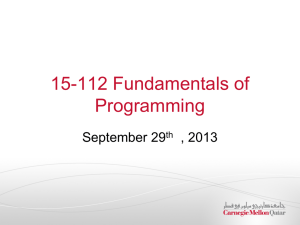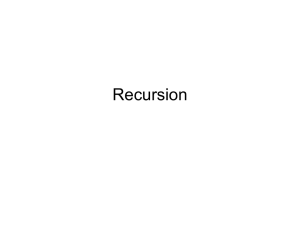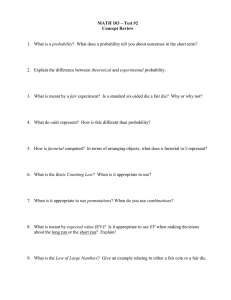Recursion
advertisement
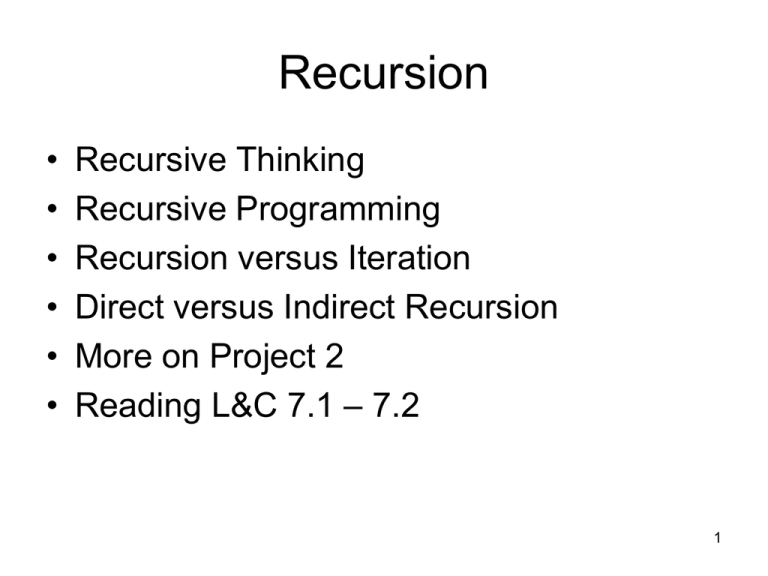
Recursion
•
•
•
•
•
•
Recursive Thinking
Recursive Programming
Recursion versus Iteration
Direct versus Indirect Recursion
More on Project 2
Reading L&C 7.1 – 7.2
1
Recursive Thinking
• Many common problems can be stated in
terms of a “base case” and an “inferred
sequence of steps” to develop all examples
of the problem statement from the base case
• Let’s look at one possible definition of a
comma separated values (.csv) list:
– A list can contain one item (the base case)
– A list can contain one item, a comma, and a list
(the inferred sequence of steps)
2
Recursive Thinking
• The above definition of a list is recursive
because the second portion of the definition
depends on there already being a definition
for a list
• The second portion sounds like a circular
definition that is not useful, but it is useful
as long as there is a defined base case
• The base case gives us a mechanism for
ending the circular action of the second
portion of the definition
3
Recursive Thinking
• Using the recursive definition of a list:
A list is a: number
A list is a: number comma list
• Leads us to conclude 24, 88, 40, 37 is a list
number comma list
24
,
88, 40, 37
number comma list
88
,
40, 37
number comma list
40
,
37
number
37
4
Recursive Thinking
• Note that we keep applying the recursive
second portion of the definition until we
reach a situation that meets the first portion
of the definition (the base case)
• Then we apply the base case definition
• What would have happened if we did not
have a base case defined?
5
Infinite Recursion
• If there is no base case, use of a recursive
definition becomes infinitely long and any
program based on that recursive definition
will never terminate and produce a result
• This is similar to having an inappropriate
or no condition statement to end a “for”,
“while”, or “do … while” loop
6
Recursion in Math
• One of the most obvious math definitions
that can be stated in a recursive manner is
the definition of integer factorial
• The factorial of a positive integer N (N!) is
defined as the product of all integers from
1 to the integer N (inclusive)
• That definition can be restated recursively
1! = 1
N! = N * (N – 1)!
(the base case)
(the recursion)
7
Recursion in Math
• Using that recursive definition to get 5!
5! = 5 * (5-1)!
5! = 5 * 4 * (4-1)!
5! = 5 * 4 * 3
5! = 5 * 4 * 3
5! = 5 * 4 * 3
5! = 5 * 4 * 3
5! = 120
* (3-1)!
* 2 * (2-1)!
* 2 * 1! (the base case)
* 2 * 1
8
Recursive Programming
• Recursive programming is an alternative
way to program loops without using “for”,
“while”, or “do … while” statements
• A Java method can call itself
• A method that calls itself must choose to
continue using either the recursive definition
or the base case definition
• The sequence of recursive calls must make
progress toward meeting the definition of
the base case
9
Recursion versus Iteration
• We can calculate 5! using a loop
int fiveFactorial = 1;
for (int i = 1; i <= 5; i++)
fiveFactorial *= i;
• Or we can calculate 5! using recursion
int fiveFactorial = factorial(5);
. . .
private int factorial(int n)
{
return n == 1? 1 : n * factorial(n – 1);
}
10
Recursion versus Iteration
main
return 120
factorial
return 24
factorial(5)
factorial
return 6
factorial(4)
factorial
return 2
factorial(3)
factorial
return 1
factorial(2)
factorial
factorial(1)
11
Recursion versus Iteration
• Note that in the “for” loop calculation, there is
only one variable containing the factorial
value in the process of being calculated
• In the recursive calculation, a new variable n
is created on the system stack each time the
method factorial calls itself
• As factorial calls itself proceeding toward the
base case, it pushes the current value of n-1
• As factorial returns after the base case, the
system pops the now irrelevant value of n-1
12
Recursion versus Iteration
• Note that in the “for” loop calculation, there
is only one addition (i++) and a comparison
(i<=5) needed to complete each loop
• In the recursive calculation, there is a
comparison (n==1) and a subtraction (n 1), but there is also a method call/return
needed to complete each loop
• Typically, a recursive solution uses both
more memory and more processing time
13
than an iterative solution
Direct versus Indirect Recursion
• Direct recursion is when a method calls itself
• Indirect recursion is when a method calls a
second method (and/or perhaps subsequent
methods) that can call the first method again
method1
method2
method3
method1
method2
method3
method1
method2
method3
14
Calling main( ) Recursively
• Any Java method can call itself
• Even main() can call itself as long as
there is a base case to end the recursion
• You are restricted to using a String []
as the parameter list for main()
• The JVM requires the main method of a
class to have that specific parameter list
15
Calling main( ) Recursively
public class RecursiveMain
{
public static void main(String[] args)
{
if (args.length > 1) {
String [] newargs = new String[args.length - 1];
for (int i = 0; i < newargs.length; i++)
newargs[i] = args[i + 1];
main(newargs);
// main calls itself with a new args array
}
System.out.println(args[0]);
return;
}
}
java RecursiveMain computer science is fun
fun
is
science
computer
16
More on Project 2
• The Recursive class for project 2 needs a
recursive drawTriangle() method
• You don’t need an explicit stack
• When drawTriangle() calls itself:
– the current context of all local variables is left on
the system stack and
– a new context for all local variables is created on
the top of the system stack
• The return from drawTriangle() pops the
previous context off the system stack
17
More on Project 2
• System Stack (for 3 triangles and 3 levels)
T1
T1.1.1
T1.1.2
T1.1
T1.1
T1.1
T1
T1
T1
18
More on Project 2
• System Stack (for 3 triangles and 3 levels)
T1.1.3
T1.2.1
T1.2.2
T1.1
T1.2
T1.2
T1.2
T1
T1
T1
T1
19
More on Project 2
• System Stack (for 3 triangles and 3 levels)
T1.2.3
T1.3.1
T1.3.2
T1.2
T1.3
T1.3
T1.3
T1
T1
T1
T1
20
More on Project 2
• System Stack (for 3 triangles and 3 levels)
T1.2.3
T1.3
T1
21
